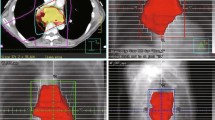Abstract
The number of patients with head and neck squamous cell carcinoma (HNC) with mediastinal involvement is small, and appropriate treatment techniques have not been widely discussed. This study aimed to compare the efficacy of radiotherapy planning techniques in reducing lung irradiation while retaining target coverage. Among all HNC patients with mediastinal involvement who underwent radiotherapy between 2007 and 2014 at our hospital, seven consecutive patients were included in this study. Four different treatment plans were generated for each patient as follows: seven-field intensity-modulated radiation therapy (IMRT), modified IMRT in which the lateral beams avoided the lungs, three-full-arc volumetric-modulated arc therapy (VMAT), and VMAT with lung avoidance. We compared the outcomes of IMRT and VMAT plans using the paired t-test. After modifications were made to avoid lung irradiation, IMRT values for V5Gy and V20Gy decreased from 713.2 to 503.6 cm3 (p = 0.011) and from 338.8 cm3 to 267.0 cm3 (p = 0.058), respectively. In the case of VMAT, lung V5Gy and V20Gy values decreased from 754.8 to 601.0 cm3 (p = 0.004) and from 328.5 to 255.7 cm3 (p = 0.020), respectively. Other factors did not significantly differ between the plans. In both IMRT and VMAT planning, lung doses were significantly reduced following the modification of the beams that cross the lungs with target coverage maintenance.



Similar content being viewed by others
References
van Rij CM, Oughlane-Heemsbergen WD, Ackerstaff AH, et al. Parotid gland sparing IMRT for head and neck cancer improves xerostomia related quality of life. Radiat Oncol. 2008;3:41.
Vergeer MR, Doornaert PA, Rietveld DH, et al. Intensity-modulated radiotherapy reduces radiation-induced morbidity and improves health-related quality of life: results of a nonrandomized prospective study using a standardized follow-up program. Int J Radiat Oncol Biol Phys. 2009;74:1–8.
Nutting C, A’Hern R, Rogers MS, et al. PARSPORT Trial Management Group: First results of a phase III multicenter randomized controlled trial of intensity modulated (IMRT) versus conventional radiotherapy (RT) in head and neck cancer (PARSPORT: ISRCTN48243537; CRUK/03/005). J Clin Oncol (Meeting Abstracts). 2009; 27(18S): LBA6006.
Verbakel WF, Cuijpers JP, Hoffmans D, et al. Volumetric intensity-modulated arc therapy vs conventional IMRT in head-and-neck cancer: a comparative planning and dosimetric study. Int J Radiat Oncol Biol Phys. 2009;74:252–9.
Bedford JL. Treatment planning for volumetric modulated arc therapy. Med Phys. 2009;36:5128–38.
Vanetti E, Clivio A, Nicolini G, et al. Volumetric modulated arc radiotherapy for carcinomas of the oro-pharynx, hypo-pharynx and larynx: a treatment planning comparison with fixed field IMRT. Radiother Oncol. 2009;92:111–7.
Clemente S, Wu B, Sanguineti G, et al. SmartArc-based volumetric modulated arc therapy for oropharyngeal cancer: a dosimetric comparison with both intensity-modulated radiation therapy and helical tomotherapy. Int J Radiat Oncol Biol Phys. 2011;80:1248–55.
Hoogeman MS, Nuyttens JJ, Levendag PC, et al. Time dependence of intrafraction patient motion assessed by repeat stereoscopic imaging. Int J radiat Oncol Biol Phys. 2008;70:609–18.
National Comprehensive Cancer Network. NCCN. Clinical Practice Guidelines in Oncology. Head and Neck Cancer. version 3. 2019.
Sobin LH, Gospodarowicz MK, Wittekind C. TNM classification of malignant tumors (UICC International Union Against Cancer). 7th ed. Oxford: Wiley-Blackwell; 2009.
ICRU. ICRU Report 50. Prescribing, recording and reporting photon beam therapy. Bethesda: International Commission on Radiation Units and Measurements, 1993.
ICRU. ICRU Report 62. Prescribing, recording and reporting photon beam therapy, Supplement to ICRU Report 5. Bethesda: International Commission on Radiation Units and Measurements, 1999.
ICRU. ICRU Report 83. Prescribing, recording and reporting photon-beam intensity-modulated radiation therapy (IMRT). Bethesda: International Commission on Radiation Units and Measurements, 2010.
Rosca F, Kirk M, Soto D, et al. Reducing the low-dose lung radiation for central lung tumors by restricting the IMRT beams and arc arrangement. Med Dosim. 2012;37:280–6.
Yin Li, Hao Wu, Gong J, et al. Volumetric-modulated arc therapy vs c-IMRT in esophageal cancer: a treatment planning comparison. World J Gastroenterol. 2012;18(37):5266–75.
Liu HH, Jauregui M, Zhang X, et al. Beam angle optimization and reduction for intensity modulated radiation therapy of non-small-cell lung cancers. Int J Radiat Oncol Biol Phys. 2006;65:561–72.
Chang CH, Mok GSP, Shueng PW, et al. Fan-shaped complete block on helical tomotherapy for esophageal cancer: a phantom study. Biomed Res Int. 2015;2015:1–6.
Hall EJ, Wuu CS. Radiation-induced second cancers: the impact of 3D-CRT and IMRT. Int J Radiat Oncol Biol Phys. 2003;56:83–8.
Purdy JA. Dose to normal tissues outside the radiation therapy patient’s treated volume: a review of different radiation therapy techniques. Health Phys. 2008;95:666–76.
Journy NM, Morton LM, Kleinerman RA, Bekelman JE, Berrington de Gonzalez A. Second primary cancers after intensity-modulated vs 3-dimensional conformal radiation therapy for prostate cancer. JAMA Oncol. 2016;2:1368–70.
Marks LB, Bentzen SM, Deasy JO, et al. Radiation dose–volume effect in the lung. Int J Radiat Oncol Biol Phys. 2010;76:S70–S7676.
Meadors M, Floyd J, Perry MC. Pulmonary toxicity of chemotherapy. Sem Oncol. 2006;33:98–105.
Tsujino K, Hirota S, Demizu Y, et al. DVH analysis for predicting radiation pneumonitis in cases of advanced lung cancer treated with concurrent chemoradiotherapy. Int J Radiat Oncol Biol Phys. 2001;51(Sup):91.
Grantzau T, Thomsen MS, Vaeth M, et al. Risk of second primary lung cancer in women after radiotherapy for breast cancer. Radiother Oncol. 2014;111:366–73.
Funding
This work was partially supported by the Japan Society for the Promotion of Science Grant-in-Aid for Scientific Research (A), [Grant Number JP25253078].
Author information
Authors and Affiliations
Corresponding author
Ethics declarations
Conflict of interest
All authors declare that they do not have any conflict of interest.
Ethical approval
All procedures performed in studies involving human participants were in accordance with the ethical standard of the institutional research committee and with the 1964 Helsinki Declaration and its later amendments or comparable ethical standards.
Informed consent
Informed consent was obtained from all individual participants included in the study.
Additional information
Publisher's Note
Springer Nature remains neutral with regard to jurisdictional claims in published maps and institutional affiliations.
About this article
Cite this article
Kawamura, M., Yoshimura, M., Nakamura, M. et al. Radiotherapy planning techniques to reduce lung irradiation in head and neck cancer patients with mediastinal involvement. Radiol Phys Technol 13, 128–135 (2020). https://doi.org/10.1007/s12194-020-00559-2
Received:
Revised:
Accepted:
Published:
Issue Date:
DOI: https://doi.org/10.1007/s12194-020-00559-2




